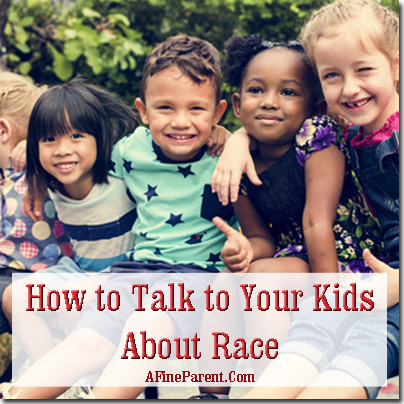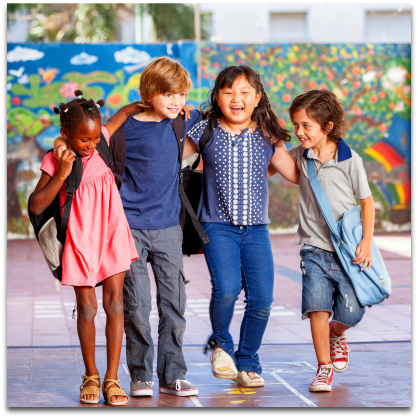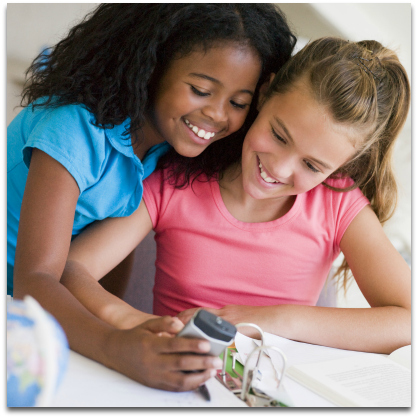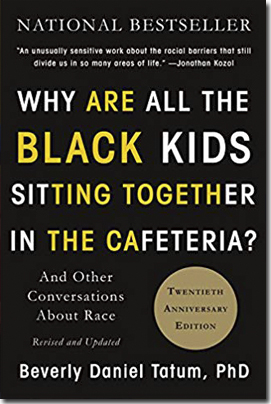 Before we dive in, take a moment to just breathe, okay? I know race is a touchy and important subject, like talking about the birds and the bees (that’s code for sex – for those of you who were spared that analogy as children) so it’s natural to have some anxiety about how or what to say and how your child will receive it.
Before we dive in, take a moment to just breathe, okay? I know race is a touchy and important subject, like talking about the birds and the bees (that’s code for sex – for those of you who were spared that analogy as children) so it’s natural to have some anxiety about how or what to say and how your child will receive it.
This isn’t relevant to just one race. It’s not a “how-to” guide for a specific group. So if you thought, “Oh, this isn’t for me,” I assure you, this is for everyone.
Imagine you’re a mother to a beautiful, curly-haired 8 year old with glowing brown skin, and you love him enough to move mountains for him.
I mean, why wouldn’t you? You literally let him reside, RENT FREE, in your body for nine months and then endured 16 hours of labor for him!
You spend nearly every waking moment thinking about how to make certain he grows to be the best version of himself, while ensuring he enjoys his childhood.
Then — all of a sudden — that very same bundle of 9 months pregnancy, 16 hours of labor and 8 years of unconditional love of a brown boy who turns to his strawberry-blond friend sitting next to him in the backseat of your car and says, “Sometimes I wish I was white like you.” As if it were nothing, as if he were simply saying, “My favorite ice-cream flavor is strawberry.”
That’s what happened to me one day as I am driving. There I am in the car, taken by surprise, and wondering how the conversation between them will continue; I’m so distracted I forget to slow down at the approaching speed bump causing the car to thud and thump out of balance.
I remain calm and quickly hit the brakes, intending to slow down, but end up pressing on the pedal a little too hard and bringing the car to an abrupt halt, jerking all three of us forward, then slamming us back into our seats again.
“Whoops — sorry! Everyone okay back there?” I apologize.
“Yes,” they reply simultaneously.
Wittily, I decide to turn this into a teaching moment and sing “thaaat’s why we wear seat belts. I was testing you.” Hoping they’ll buy that excuse, I can’t help but think about what my son said. I give myself a mental reminder to ask him about it later.
That ends the conversation until we get home, where I ask him about what he said in the car.
“I don’t really wish I was white, Mom,” he says. “I just wish it were fair.”
He hurriedly unties his shoelaces, wanting to go play with his friend, while explaining, “Today Jason stole Ezra’s watch during recess. Ezra told Mr. Clark, but he just ignored him. So Ezra went to Jason and asked him to return it, but he refused. Then they started fighting. Mr. Clark gave Ezra detention and another teacher saw what happened and asked why Jason wasn’t given detention too. Mr. Clark said ‘People like him are lucky they can even attend this school, and now his kind is encouraging violence.’”
At that moment, my son’s friend who had been listening while waiting for him says, “Yeah, everyone saw it! The big kids said it’s because Jason is white and Ezra is black! What’s so special about being white? Why do black kids get detention more?”
Feeling unprepared for such blunt questions, I string together some shaky words. But afterwards I begin to wonder if I said too much, or maybe I said too little?
Should I have said anything in front of someone else’s (white) child? Is that a separate talk?
I call my son’s friend’s parent, who is a close friend, and tell them everything. Our kids are best friends, so we know they are just going to compare notes and might as well sit them down together, we decide. I knew parenting would involve tough conversations, but where do you even start with something like this? Before we could sit down with our kids, we needed to do a little homework. Here are some of the things we learned.
How to Have “the Race Talk”
 Honestly, talking about race can be a sensitive and difficult thing to do. However, given what’s been happening in the past week, and our long and troubled history, I’d argue that it’s necessary for every parent to have these talks with their children.
Honestly, talking about race can be a sensitive and difficult thing to do. However, given what’s been happening in the past week, and our long and troubled history, I’d argue that it’s necessary for every parent to have these talks with their children.
Racism is still real even when it isn’t directly affecting our kids, and even when we aren’t around to look out for them. If we don’t prepare our children, the consequences can be dire, and sometimes irreversibly so. A parent choosing to avoid or postpone a few small talks can find themselves unintentionally doing a lot of harm.
Like many, I used to be lulled by the notion that if I didn’t mention race, children wouldn’t notice other people’s skin color. I told myself it wasn’t necessary, and I didn’t want them to be aware of any differences at such an early age. I suppose we do this because we want our children to feel safe and accepted — as if the sooner we burst the bubble of truth, the less safe they are.
But actually, it’s the opposite. Studies show that children start assigning meaning to skin color at 18 months and can distinguish different races by 3 years old. Dr. Erin Winkler, a professor at the University of Wisconsin-Milwaukee, says in her published article Children Are Not Colorblind that children notice skin color like any other physical difference (height, weight, length of hair, etc.). As they grow and develop, they are learning to categorize things like shapes, colors and also people.
This means our kids are learning about race regardless of whether we’re talking to them about it or not.
If left uninformed, they’ll fill in the blanks with whatever they are exposed to, including unreliable sources — and ones that can do real damage. If we don’t initiate the conversation, someone will beat us to it and possibly set a negative precedent, imprinting damaging and wrong information about race in their minds.
You might be thinking, schools already teach about the history of discrimination, colonization and slavery, right? True, but they often do it in a way that implies racism was a part of history, as if today we’re all equal and have the same opportunities for social and economic success. Dr. Winkler states that kids “may mistakenly assume that the unequal racial patterns they see are earned or justified,” rather than the product of ongoing systemic injustices. This is how stereotypes take seed in young minds. A child (even a child of color) can grow up thinking that poverty is intrinsic within the culture of people of color because they have classified them ‘lazy or uneducated’.
How can kids learn to debunk and filter through a lot of the misinformation they receive, if we don’t talk about it?
Hundreds of years of injustice are the root of what we see prevalent today, so we probably won’t fix it overnight, but we can still raise informed children as we move forward. Here are 6 effective tips for getting the conversation started for any family.
#1: Educate Yourself First Before Trying to Educate Your Child
 To have thought-provoking and impactful conversations about race with children, parents should be comfortable discussing it themselves.
To have thought-provoking and impactful conversations about race with children, parents should be comfortable discussing it themselves.
It’s normal to be intimidated. Don’t stress! There’s a way to rise above this! The first step is to decide to be intentional about becoming more informed.
Julie Lythcott-Haims, who wrote the book Real American, says that people need to actively seek out information about people who are different from them. Parents need to think about the community their kids are growing up in and teach their kids about the ways people are treated unfairly due to race.
Whether it’s intentional or not, maybe you aren’t exposed to people who are different from you, but the best way to learn is by getting access to other people’s experiences. I’d suggest tuning into the news and learning the history of racial divisions in order to understand why things are still so imbalanced.
Look for resources: documentaries, such as 13TH, and books like Beverly Daniel Tatum’s Why Are All the Black Kids Sitting Together in the Cafeteria? can be great resources. It’s all about making an effort to learn about other perspectives.
#2: Teach Your Kids by Example
 Conversations are CRUCIAL, but our children will inevitably also learn from the examples we set for them. They observe our patterns. A really good way to balance both conversation and example is by learning WITH our kids.
Conversations are CRUCIAL, but our children will inevitably also learn from the examples we set for them. They observe our patterns. A really good way to balance both conversation and example is by learning WITH our kids.
- Read books about racism and people who are different from themselves together
- Travel to other neighborhoods, cities or even countries
- Visit the local museums together
- Join in on real celebrations of other people’s cultures and take your children so they can experience it
- Expose them to art, food, and even clothing that are important to other cultures so they can embrace these different traditions
- Teach them what cultural appropriation is, and why it’s not okay. (Recently, I got rid of my Native American Halloween costume. It didn’t make sense to wear something that’s sacred to another ethnicity just for a fun night out)
- A lot of movies and TV shows have taken characters and even important figures and portrayed them as stereotypes of their ethnic groups. A common example is when Asian (Chinese, Korean, Indian, Pakistani, etc.) characters almost always have atrociously exaggerated accents. It’s important to note that accents are just when people use the rules of their native language to speak another language. Speaking more than one language is both impressive and provides more opportunities than being monolingual, but the media corrupts these facts and uses it to humiliate Asians and other groups. Until we have more diversity and character accuracy, we should point out these issues when we watch shows with our kids. Maybe someday soon there will be nothing to point out, but for now, it’s important not to stay silent when you see this.
- When racial incidents are on the news, discuss the injustice with your kids and ask what they think of it.
With all this exposure, expect a lot of questions from your child. Of course, you want your kids to think you know everything, but it’s okay if you don’t. You should admit it when you don’t know something and teach your kids that it’s okay to admit uncertainty and learn together
#3: Mindfulness and Kindness Over Tolerance
 A term that’s often thrown around is “racial tolerance.” This really makes me cringe. What’s that supposed to mean? One tolerates a neighbor’s loud music at 7 am on a Sunday morning, one tolerates a coworker’s need to show them cat videos every day. Other races aren’t something we have to bear like some kind of annoying or uncomfortable experience! So let’s drop that term forever, please, and focus on encouraging mindfulness.
A term that’s often thrown around is “racial tolerance.” This really makes me cringe. What’s that supposed to mean? One tolerates a neighbor’s loud music at 7 am on a Sunday morning, one tolerates a coworker’s need to show them cat videos every day. Other races aren’t something we have to bear like some kind of annoying or uncomfortable experience! So let’s drop that term forever, please, and focus on encouraging mindfulness.
Mindfulness is important when helping a child navigate their curiosity. Children often don’t put value on something until they see how we react to something, so when your child asks you, “Why do they look like that?” and you shush them because you think it’s impolite, it shuts down the conversation and signals to the child there’s something wrong. Dr. Susan Linn, child psychologist says that we should aim to raise children who are curious about differences. By sending the message that differences in race and ethnicity aren’t bad, we can help teach our kids that differences are interesting, not scary.
However, be aware of whom and how your child is asking. It’s not right to expect a person of color to “teach” you or your child about racism. Do your own research online and in books, and make sure you ask appropriate questions at the right time and place.
If you have older children who are knowingly saying racist remarks or using racial slurs, I suggest being stern. Maybe you’ve been liberal about other things in the past and they got the impression this was okay too. Or maybe they picked it up elsewhere. Be honest and explain why their behavior is destructive. In the article How to Talk with Kids about Race and Racism, Rosalind Wiseman, founder of Cultures of Dignity says, “I tell my children, ‘Sometimes we joke, or sometimes Mom drops an F-bomb, but there is a very large difference between swearing because you stubbed your toe, and saying something to intentionally put someone down’.” Intervene in the moment so it won’t happen again!
Be open about addressing mistakes. There may come a point where your child says the wrong thing and offends someone. They should avoid rushing into self-defense mode (and thus completely missing the point); instead, your child should focus on understanding why the other person is offended.
Julie Lythcott-Haims suggests saying, “I am so sorry. I didn’t mean to offend. What do I need to do to ensure I am not making that mistake again?”Kids need to learn to take responsibility when they’ve made a mistake and use it as a learning opportunity.
She also notes that racism isn’t always obvious. Sometimes it’s our beliefs in problematic stereotypes. Lythcott-Haims recommends acknowledging implicit bias and exposing our kids to people who are different.
#4: Practice Self-Love
 I’m a huge advocate of encouraging children to love themselves. They should see the beauty in themselves and in people who don’t look like them.
I’m a huge advocate of encouraging children to love themselves. They should see the beauty in themselves and in people who don’t look like them.
Instill the value of respecting differences because there are no colors that are better than others. Show them how their race is an important part of who they are, but not so important that it trumps another aspect. Diversity is what makes being human so exciting and beautiful!
Children whose race or ethnicity makes them in the minority in many environments sometimes pick up the message that people look down on their race, and they might “decide” they’d rather be another race or ethnicity. Ask them why they feel this way in order to take the best steps to reinforce a positive image of their race so they don’t feel less than another group.
Growing up as a black woman, I generally liked how I looked (I still do), but I insisted on keeping my hair straight — to fit in — instead of just enjoying my curls. There’s nothing wrong with straighter hair, but there’s DEFINITELY something wrong with changing yourself for the wrong reasons. Encourage confidence in individualism.
Children of multiracial and adoptive families will want to know why they look different. It’s a good idea to explain that each family is different. If your children are multiracial, point out that they are a mix of both parents. Draw attention to facial features that look similar, such as their eyes or other features you have in common. Adoptive parents can explain that children and parents don’t have to “match” to be a family and that it doesn’t change how much love is shared.
#5: Pay Attention to Your Child’s Environment
 Take note of what your children are exposed to. What are they seeing and hearing in school, in the media, even at home?
Take note of what your children are exposed to. What are they seeing and hearing in school, in the media, even at home?
Television often paints distortions of race. If you notice characters being portrayed in a stereotypical and demeaning way, enlighten your kids about what you see and why it is wrong.
Ask the teachers about the curriculum and what they do to ensure a safe and just environment for all students. Ask your children questions: Do they feel discriminated against? Have they witnessed discrimination against another student? If all their friends look like them, ask about it. Look out for any potential toxic friendships.
When it comes to friends or relatives in your home, don’t tolerate bigoted language. Wiseman suggests you tell them directly that this language is not acceptable. You can say, “In this house, we don’t use that type of language.” This teaches kids that it’s okay to speak up, even when you’re not around.
#6: Advocating and Teaching Safety and Caution
 If you have children of color, introducing racism to them might worry you. It’s scary, especially if you’ve experienced racism. But they’re the ones who need to feel the most empowered.
If you have children of color, introducing racism to them might worry you. It’s scary, especially if you’ve experienced racism. But they’re the ones who need to feel the most empowered.
When people have hatred toward you for reasons that are beyond your control, like the way you look, it’s confusing, and your child will likely start thinking: How can I survive this? How can I get treated with respect?
Racism isn’t bullying. There isn’t just a mean group picking on another group. It’s a system. It’s complex and subliminal, taking many forms both visible and invisible. Your child will see and feel it.
It’s your responsibility to prepare them for that, even if it’s a subject that provokes fear. How you use fear is important. Some panic and silence themselves, but fear can also make you do radical things — it forces you to cry out when something isn’t right. Those cries make people listen and call attention to a problem.
If you hide from what you fear, you change nothing! No one benefits or learns from it. Teach your kids that it’s okay to be afraid and cautious and practice vigilance, but they shouldn’t paralyze themselves. They should be informed and know when to speak up; this way they’ll grow up to be a part of the voice that drives out the plague. Make them aware of how far society has come because of the people who came before them and said something.
White people have responsibilities in advocating against racism as much as anyone else. The Teen Vogue Article How White People Can Hold Each Other Accountable to Stop Institutional Racism explains the difference between active and passive racism: “One way to start is to ask yourself how you’re taking action each day to make a material, visible difference for black people and people of color.” It’s important to teach white kids that they have a responsibility beyond avoiding overtly racist comments or actions.
 In his article Race, Kids–and the Peril of Silence, Brian Gresko says: “It’s a challenge on many levels for white Americans to figure out how to talk about racism to our kids when our personal and cultural background has given us the privilege of ‘humor’ or silence. Yet, we must — because that silence equals complicity and that humor equals erasure.”
In his article Race, Kids–and the Peril of Silence, Brian Gresko says: “It’s a challenge on many levels for white Americans to figure out how to talk about racism to our kids when our personal and cultural background has given us the privilege of ‘humor’ or silence. Yet, we must — because that silence equals complicity and that humor equals erasure.”
Unless a white person is actively “anti-racist,” a term coined by author Beverly Tatum in her book Why Are All the Black Kids Sitting Together in the Cafeteria?, they will find themselves still being a part of the problem. Silence is a problem.
The fight against racism is more powerful when we are all on the same team. Relinquish the privilege of being comfortable in the minor and major injustices around you by calling them out, and your child will follow in your footsteps. This way in the event that your child and another child of color find themselves in a situation where the child of color is being discriminated against, they can unite and both ask why they are being treated differently, leaving no room for unequal treatment.
It’s easier to love when you know we have a responsibility to each other to do what’s right.
The 2-Minute Action Plan for Fine Parents
Plan for a marathon, not a sprint. There are no perfect words that our children completely understand that make them feel inspired to embrace everyone, but there are a few questions you can ask yourself when you feel a little overwhelmed so you can make sure you keep doing this important work:
- Have I done enough to prepare myself to make sure I’m informed about my own and other people’s races?
- How can I minimize hateful influences in my child’s environment?
- How can I teach my children to be self-aware and practice safety while also encouraging them to be vocally anti-racist?
The Ongoing Action Plan for Fine Parents
- Take time to learn something new WITH your child, while keeping it engaging and interesting for them.
- Be a good role model by showing mindfulness and kindness to everyone, even people who are a different race. Engage yourself and your child in relationships with different kinds of people to debunk stereotypes.
- Reassure your child to see the beauty in themselves while also appreciating other races’ differences.
Thanks for sharing your thoughts Tatiana. Highly Appreciated. Keep up the good work
Love it, it’s definitely important to know how to do this properly and efficiently, clients LOVE these.
Thank you so much for sharing your experience and wisdom. I am a director of religious education at my neighborhood church as well as parent of five grown children with four grandchildren. I believe in continuing education for myself. Discrimination and racism are an area that I am not very educated in. Having no idea on wear to begin myself I am grateful for your suggestions. I am sharing your article with all the parents I know.
God Bless,
Mary
Hi Mary, that’s great, I’m happy to hear that. The best time to start learning is always now. I wish you and your family the best.